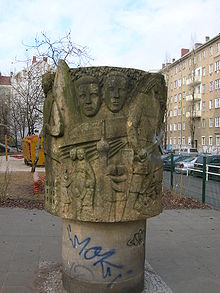Ernst Knaack
This article needs additional citations for verification. (August 2007) |
Ernst Knaack (4 November 1914 - 28 August 1944) was a German Communist and resistance fighter against the Nazi Germany régime.

Biography
Knaack was born in Berlin.
In 1928 he joined the Communist Youth League of Germany (KJVD). He performed the function of leader for agitation and propaganda in the Berlin neighbourhood of Prenzlauer Berg. From 1933, he fought illegally against Nazi domination.
In 1935, he was arrested for the first time, and on 2 October 1936, the Berlin Superior Court of Justice (Kammergericht) sentenced him to two years at hard labour in a Zuchthaus. After being released, Knaack joined the illegal organization around Robert Uhrig. On 26 March 1942, he was once again arrested by the Gestapo and taken to Sachsenhausen concentration camp, where he stayed more than two years until his trial. On 6 July 1944, the Volksgerichtshof handed down a death sentence to Knaack. He was executed at Brandenburg-Görden Prison in Brandenburg an der Havel.
Knaackstraße, the Ernst Knaack Youth Centre – later known as the Knaack Klub (Greifswalder Straße 224 in Prenzlauer Berg, Berlin) – and the Ernst Knaack Fourth Polytechnic Secondary School (Kastanienallee in Prenzlauer Berg) are named after Ernst Knaack. The stele "Traditionen der deutschen Arbeiterklasse" ("Traditions of the German Working Class") by Heinz Worner (Knaackstraße 53-67 in Prenzlauer Berg) is dedicated to the murdered antifascists Ernst Knaack and Siegmund Sredzki.
Further reading
- Luise Kraushaar et al. Deutsche Widerstandskämpfer 1933 - 1945. Biografien und Briefe. Vol. 1, Karl Dietz Verlag Berlin Berlin (1970) page 506ff
- Stephan Hermlin. Die erste Reihe, Verlag Neues Leben, Berlin 1951, Seite 92ff der fünften Auflage 1985
- 1914 births
- 1944 deaths
- People who died in Brandenberg concentration camp
- Communists in the German Resistance
- German communists
- German people of World War II
- German resistance members
- Executed communists in the German Resistance
- People condemned by Nazi courts
- People from Berlin executed by Nazi Germany
- Resistance members who died in Nazi concentration camps
- German civilians killed in World War II
